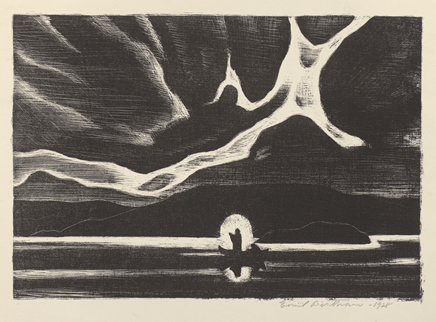Bisttram executed a larger version of this work in oils which is now in the collection of the Albuquerque Museum, where it is titled Sea of Galilee.
While Sea of Galilee seems like an appropriate title, the image does not depict any of the usual stories of Jesus on the Sea of Galilee. The main idea of the picture seems to be the relationship between the large figure in the sky and the smaller figures in the boat, which suggests that the subject is the relationship between the macrocosm and the microcosm, a major tenet of theosophy. According to theosophy, the human being is the microcosm who holds within itself the germ of the macrocosm who is the Logos or the Creator. Through an evolutionary series of transformations over eons of time, the microcosm eventually reunites with the Logos.
The background and setting for this picture recall watercolor studies that Bisttram made while visiting Monhegan Island during the summer months while he lived in New York.
This work is similar to another painting that Bistttram executed which is titled Communion, 1929. Two people are in a boat, one standing, and one seated, but neither encircled by a halo. To the left, against a mountain range is a religious apparition encircled by a halo of light.
Both these works are symbolic in nature and have sources in the paintings of Nicholas Roerich. Additionally, there is a painting with a similar feeling by Bisttram’s mentor Howard Giles titled 139th Psalm.

